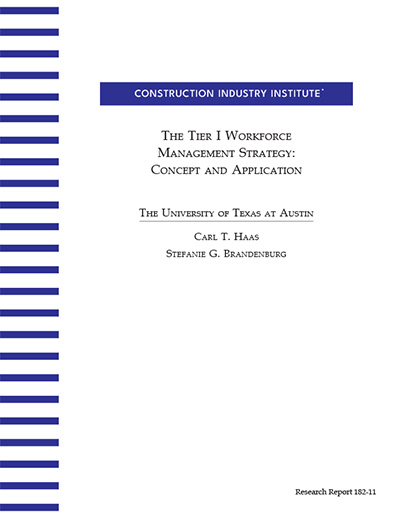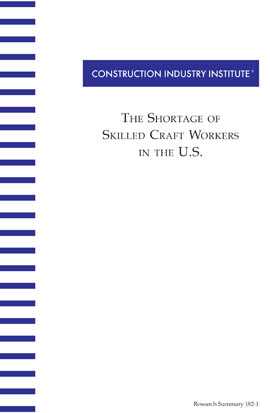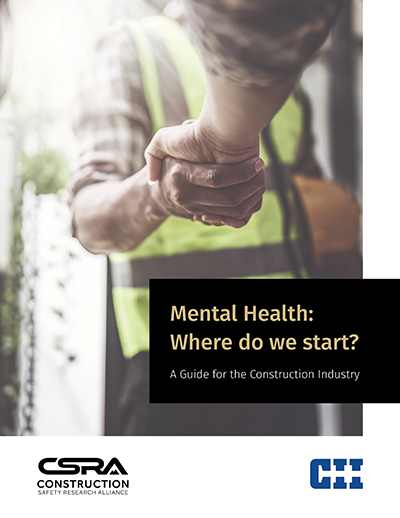
The Tier I Workforce Management Strategy: Concept and Application
Shortages of skilled craft workers continue to plague the construction industry. Employers have attempted to identify the root causes and to develop strategies to overcome these shortages. The Construction Industry Institute (CII) and others have funded research on the problem and generated potential solutions. The industry now uses, although sporadically, a number of initiatives including craft and supervisory training, multi-skilling, and self-directed work teams as well as productivity enhancements utilizing technology, constructability, and prefabrication. Efforts to quantify or qualify the resulting benefits, however, have been unsatisfactory.
Despite this research and the efforts to stem the problem, the construction industry’s skilled worker pool continues to shrink. The decreasing number of young people entering the work force and the failure to recruit from non-traditional labor pools both contribute to this troublesome trend. Over the past thirty years, real wages of construction workers have declined relative to those of other workers. Poor industry image, tough working conditions, and the industry’s perceived poor safety record (despite the stellar performance in safety by CII members) also have contributed to the decline in the number of people willing to enter and remain in the industry.
In 2001, CII commissioned PT182, Addressing the Shortage of Skilled Craft Workers in the U.S., to conduct a study on recruiting and retaining qualified craft workers. Based upon its examination of the industry, the project team concluded that:
- The journey-level work force includes as many high school graduates as the rest of the U.S. population.
- The construction industry is failing to attract women and minorities.
- The construction work force can be characterized as two divergent work forces: one that is satisfied with the work and is willing to participate and improve skill levels; and a second that is transient, unsatisfied, and will quickly leave the industry when other opportunities arise. These two work forces have vastly different characteristics and need to be managed accordingly, thus there is a need for two different work force management strategies.
- The skilled workforce shortage must be addressed as both a supply and a demand problem.
- Currently the industry is not utilizing any formal, structured work force management strategies, nor does it have a way to measure the success of its current management practices.
PT 182 found a particular interest in a recent collaboration between CII and the Center for Construction Industry Studies (CCIS). That study produced a theoretical model for a revolutionary new way to address the issue in a more comprehensive manner. Although the method, called “Tier II,” is new and future-oriented, it may have a considerable impact on the construction work force and industry.
PT 182 developed a complimentary strategy to Tier II to address the work force shortage: Tier I. It is based on the concept that productivity gains from optimal management of the work force will relieve pressure on demand and will encourage workers to remain on a project and in the industry. These productivity gains will be achieved by applying training, collaboration, and the use of technology in a systematic way to maximize the effectiveness of the front-line supervisors. Tier I proposes that the cohesive, structured implementation of industry accepted best practices will improve the management and utilization of the work force. It is anticipated that this will lead to improved productivity, reduced absenteeism and turnover, and eventually to overall project success.
It is important to note that the focus for Tier I is on the management and supervision of the work force on a project. Explicitly choosing a work force management strategy in early project planning stages should allow for systems to be put into place, recruitment to be focused, and crews to be structured in a way that will result in better project performance.
As pointed out, the Tier I Strategy is not new and it is not revolutionary. It is, however, a comprehensive combination of many of the construction industry’s best practices associated with workforce management. It is important for the industry to move away from emergent strategies and adopt more deliberate, structured strategies.
This research has the potential to increase awareness in the industrial construction industry for the need for a workforce assessment process that drives a workforce development strategy. It is probable that the metrics developed in this research could be used as the forerunners for workforce management metrics that drive industry improvement the way safety metrics have driven improvements in safety in many CII member companies in the last 15 years.
This research also presents one of the most thorough examinations of the characteristics of the journey-level and supervisory workforce in the construction industry. This information should help to dispel some of the common assumptions of the workforce, assisting industry leaders in the recognition of strategies that will best address the realities of that workforce.
Implementing a Tier I or Tier II Work Force Management Strategy will require management commitment. Part of this commitment is the utilization of the Tier I and Tier II Metrics that help to evaluate the implementation of these strategies. Implementation guidelines and a Work Force Assessment Package have been developed and are discussed in this document.
RR182-11, Basic Implementation Guidelines
Outlines the basic implementation concepts that should help industry practitioners develop an understanding of the Tier 1 strategy. The guidelines include these 5 stages: (RR182-11, p. 91)
- Stage 1 – Clarification
- Stage 2 – Assessment
- Stage 3 – Design
- Stage 4 – Implementation
- Stage 5 – Monitoring



